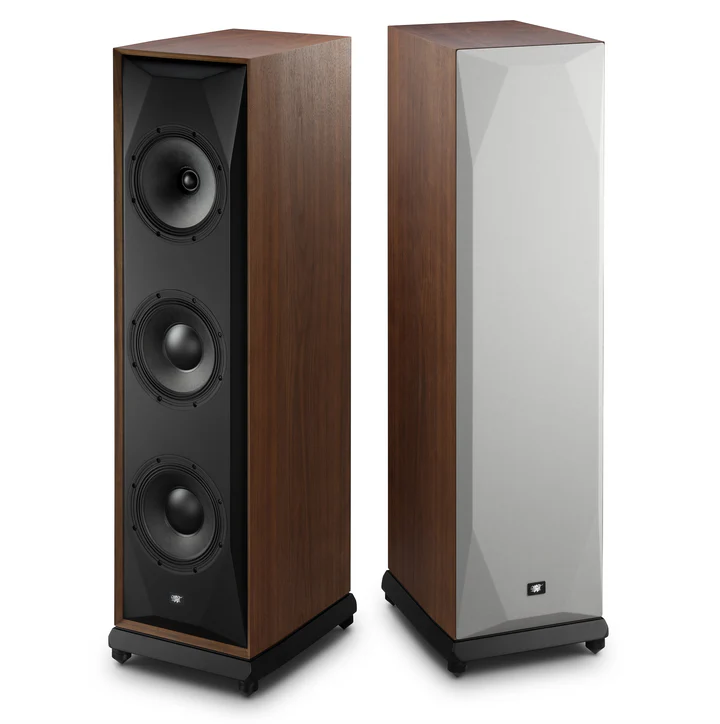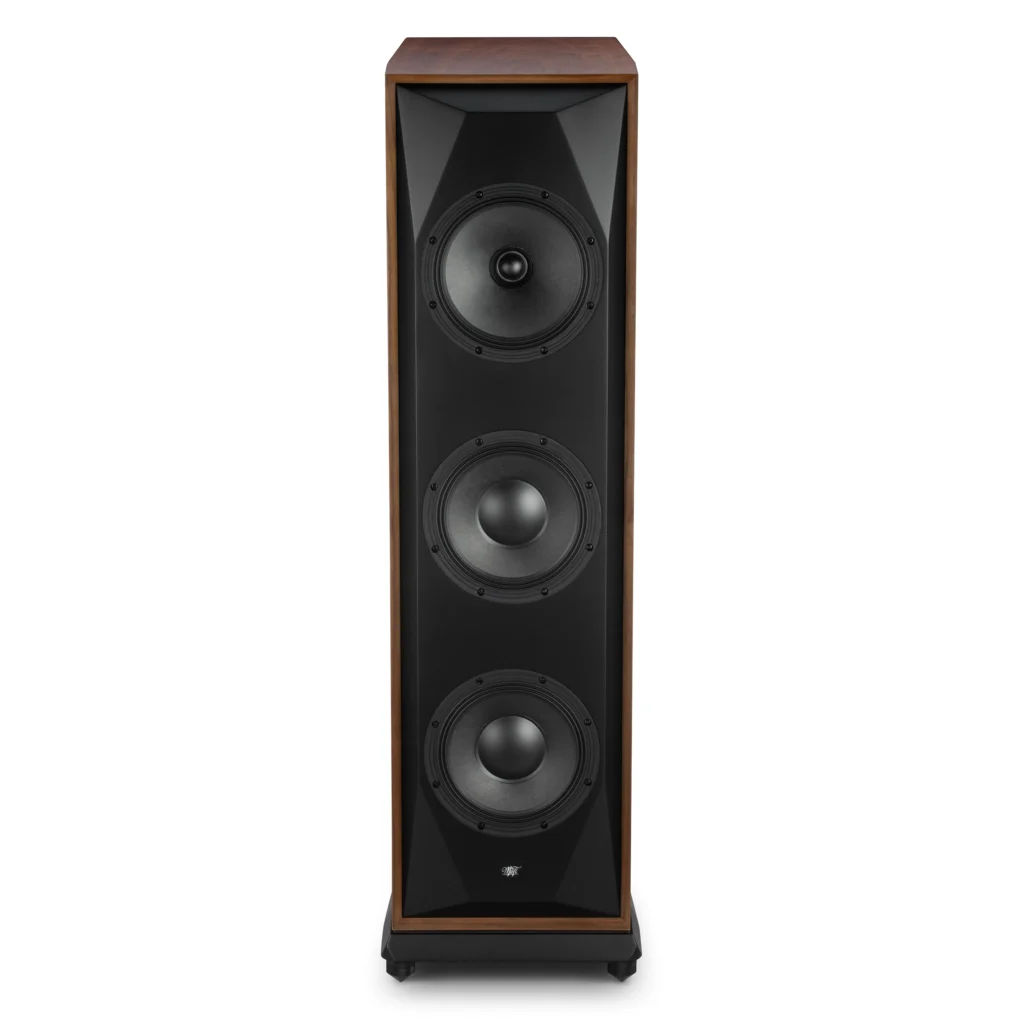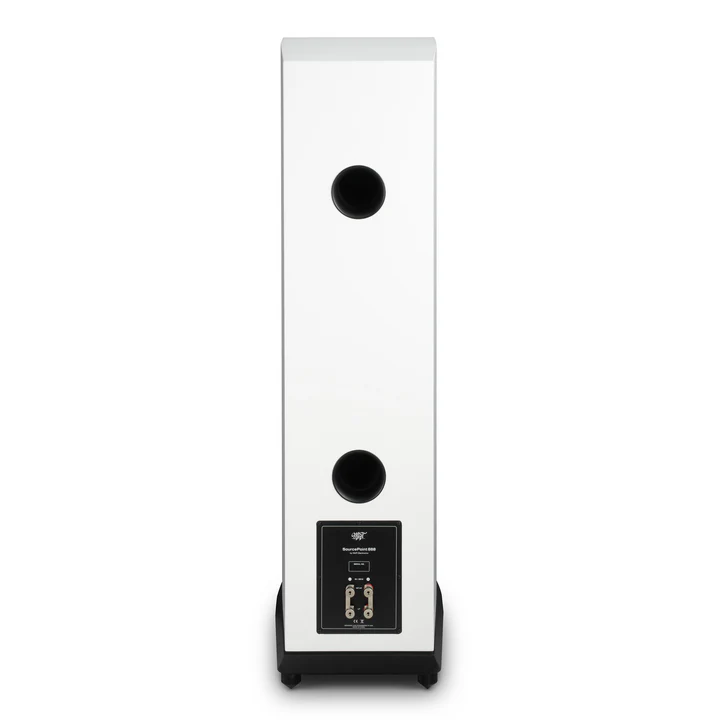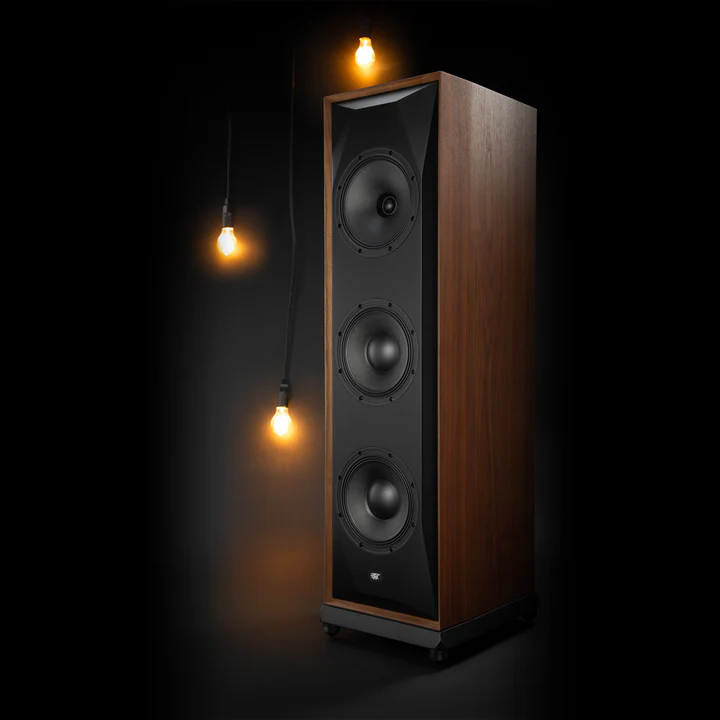I’m a little late to this one, but I finally got my hands on the MoFi SourcePoint 888, the third speaker to come out of the collaboration between MoFi Electronics and legendary speaker designer Andrew Jones. If you’re unfamiliar, Jones has built speakers for ELAC, KEF, Pioneer, and Infinity Systems; he’s as experienced as they come.
The SourcePoint 888 is the first floorstanding model in the lineup, following the standmount SourcePoint 8 and SourcePoint 10. Its name comes from the three 8-inch drivers inside, the same 8-inch drivers used in the standmounts. These drivers use a concentric design, a configuration Andrew Jones has been using for some time.
In the product manual, Andrew Jones said that his goal for the SourcePoint 888 was to enhance the technology and sound quality of the SourcePoint 8 and elevate it to an even higher performance level. And while I haven’t looked at the SourcePoint 8 yet, I think the 888 is going to sound amazing.
Design and Build Quality
The MoFi SourcePoint 888 price in 2025 is $5495. They come in five finishes: White, Black Oak, Walnut, Satin Walnut, and Black Ash. A single unit weighs in at 96.2 lbs, or 43kg, and the dimensions are 320mm x 410mm x 1070mm without the grille. These speakers employ a multi-faceted front baffle to eliminate diffraction, and they come with magnetic fabric-wrapped grilles if you want your drivers to have protection.

This loudspeaker was built in a 3-way vented box system configuration with concentric drivers for superior sound dispersion. It has a 1.25-inch wide roll soft dome tweeter and dual 8-inch paper cone woofers. On the rear, you have two sets of binding posts to allow for bi-wire and bi-amp connectivity.
The tweeter sits inside the midrange driver in a concentric design, which ensures a more natural playback because the frequencies are produced from the same point, just like in real life. Each driver operates in its own isolated chamber, which helps reduce unwanted resonances and keeps the bass from interfering with the midrange clarity.
The two 8-inch woofers are dedicated to frequencies below 130 Hz, freeing the concentric driver to focus solely on midrange and treble performance. These woofers also feature opposing neodymium magnets with a short coil in a long gap, delivering a uniform magnetic field and precise cone control.

The SourcePoint 888’s cabinet feels exceptionally rigid; there’s no audible vibration or resonance even at high volumes, suggesting MoFi prioritized structural damping. Though MoFi doesn’t specify materials, the solid feel points to dense MDF or a similar construction. One thing is clear: these loudspeakers were built to last. Just don’t touch or mess with the drivers, and you’ll be good.
The feet are supplied as separate pieces, a threaded rod, a locking ring, a cones (for carpets), or flat feet (for hard floors). You choose the appropriate one, screw it in, level the speaker, and then secure the locking ring to lock everything in place. The manual also warns that spikes are meant for carpeted floors only and should not be used on hard surfaces to avoid damage.
Setting Up The SourcePoint 888 Loudspeakers
The SourcePoint 888 loudspeakers have a combined frequency response of 32Hz – 30kHz, a nominal impedance of 6 ohms, and a sensitivity of 87dB. Now, the nominal impedance can go down to 4.5 ohms, and I recommend a good amplifier to get the most out of these floorstanding loudspeakers.
I used my reference Devialet Astra integrated amplifier, and its 300 watts into 4 ohms seemed very much overkill. Don’t get me wrong, the performance with this amplifier was amazing, but you can go for an amplifier with at least 100 watts, and you’ll be good.
For speaker placement, I followed the instructions in the user manual, placing the SourcePoint 888s in an equilateral triangle with my main listening position. Given their considerable height and depth, I placed the speakers 3 feet away from my walls and 9 feet apart. If you place them too close to walls, you’ll get boomy bass and lose that precise imaging the concentric design is known for.

The user manual also recommends rotating the speakers towards the listeners to utilize the concentric driver and improve imaging. As always, to determine which sounds best, play some music and listen to the size and scale of the sound field, and how focused the center voices sound.
Sound Quality
The MoFi SourcePoint 888s deliver bass that’s both impressive and controlled. Those dual 8-inch woofers work together to produce low-end extension that reaches down to 32Hz, giving you that subwoofer-like presence without the bloat. The bass hits with authority, but it never overwhelms the rest of the frequency range. You get punch and weight when the music calls for it, but also the articulation to hear every note in a walking bass line.
Testing with Daft Punk: “One More Time” really shows off what these speakers can do in the low end. That pulsating electronic bass line stays tight and controlled even at higher volumes, never turning into a boomy mess. The same goes for more challenging content like the opening bass drop in Billie Eilish’s “Bad Guy”; the 888s reproduce those ultra-low frequencies with surprising authority for speakers this size. In movies, the T-Rex footsteps in “Jurassic Park” have a genuine impact that you feel in your chest, while the pod race sequence in “The Phantom Menace” delivers all that low-frequency rumble without losing clarity in the dialogue.
The midrange is where these speakers shine. That concentric driver design pays off big time here; vocals sit exactly where they should in the soundstage, with natural weight and presence. Dialogue becomes crystal clear, and if you’re having trouble with clarity, a bit of toe-in works wonders. Piano recordings sound particularly good, with each note having the right amount of body without any artificial coloration. Testing with Adele’s “Skyfall” shows just how well these speakers handle powerful vocals; her voice comes through with all its emotional impact while maintaining perfect clarity even during the most dynamic passages.
The highs are smooth and extended without any harshness. That soft dome tweeter mounted concentrically delivers detail without fatigue, even during longer listening sessions. You’ll notice this especially with acoustic instruments; guitar strings have that natural shimmer, and cymbals decay naturally without any metallic edge. Radiohead’s “The National Anthem” puts the treble to the test with its compressed drums and piercing cymbals, and the 888s handle it all without ever sounding harsh or fatiguing.
In terms of soundstage, the SourcePoint 888 loudspeakers create a wide, stable image that rivals much expensive counterparts. The concentric design means everything stays locked in place as you move around, and the imaging precision is genuinely impressive for speakers this size. You get excellent depth and separation, making it easy to pick out individual instruments in complex mixes. During the sequence in “Dune 2”, where Paul makes his speech in front of the fremen, the layered soundscape spread across my room with remarkable precision, placing every sound effect exactly where it should be, and the depth of the dialogue was perfect.
The 888s do need some proper amplification to sing. While they’re not impossibly demanding, giving them clean power brings out their best qualities and keeps that bass tight and controlled.
Verdict
At $5,495, the MoFi SourcePoint 888s are an easy recommendation if you have the room and amplification to support them. These speakers deliver performance that typically costs twice as much, combining the imaging precision of high-end loudspeakers with the scale and bass extension of much larger systems.
The 888s excel at making you forget you’re listening to speakers at all. They draw you into the experience, which is exactly what great speakers should do.
You’ll need a decent-sized room, at least 12 feet between you and the back wall – and an amplifier with some real power behind it. If you’re in a small apartment or running a basic receiver, these aren’t for you. But if you have the space and gear to let them breathe, the 888s will likely be the last speakers you’ll need to buy.
What’s In The Box
- 2 Floorstanding loudspeakers
- 2 Grilles
- 8 Isolation feet
- 8 Spike feet
- 8 Threaded-rods
- 8 Locking-rings
- 4 Jumper-plates (pre-installed)
- User Manual
Specs
Frequency Range: 32Hz-30kHz
Nominal Impedance: 6 Ohms, 4.5 Ohms minimum
Sensitivity: 87dB/2.83V/1m
Crossover Frequency: 130, 1.6kHz
Max Power Input: 200W
Tweeter: 1.25″ wide roll soft dome
Midrange: 8” Paper Cone
Woofer: 2 x 8″ Paper Cone
System Configuration: 3-way vented box, concentric driver
Cabinet Finishes: Satin black painted baffle/satin real wood Walnut or Black Ash veneer Dimensions: (W x H X D) 320 x 410 x 1070 /(12.6” x 16.1” x 42.1”)
Weight: 96.2 lbs / 43 kg
Not sure what these specs mean? Check out our Guide To Speaker Specifications.
FAQs
What is the MoFi SourcePoint 888 price?
The current retail price is $5,495 per pair, which represents excellent value for this level of performance.
Do the MoFi SourcePoint 888s need a subwoofer?
No, you won’t need a subwoofer with the SourcePoint 888s. Their dual 8-inch woofers deliver bass extension down to 32Hz, which covers the fundamental frequencies of most music and movies. The low-end has enough weight and impact to satisfy most listeners without additional reinforcement. However, if you do choose to add a subwoofer later, the 888s will integrate well since their bass is clean and controlled.
What amplifier power do I need for the SourcePoint 888s?
You’ll want at least 100 watts per channel from a quality amplifier. While the 888s have a sensitivity of 87dB, their impedance can drop to 4.5 ohms, which means they benefit from an amp with good current delivery. More power will give you better bass control and dynamics, but you don’t need to go overboard; 150-200 watts from a solid amplifier will be plenty for most rooms.
How much room do the SourcePoint 888s need?
These speakers need space to breathe. Plan for at least 3 feet from any wall and position them 8-10 feet apart for optimal soundstaging. Your listening position should be at least 12 feet from the back wall to avoid bass buildup. In smaller rooms, you might find the bass overwhelming and the soundstage cramped. They’re designed for medium to large listening spaces.
How do the SourcePoint 888s compare to bookshelf speakers?
The main advantages over bookshelf speakers are bass extension and scale. You get the imaging precision of good monitors but with the low-end authority and dynamic range of larger speakers. The concentric driver design means you’re not sacrificing midrange clarity for that extra bass. However, bookshelf speakers like the KEF LS50 Meta might have slightly better imaging in smaller rooms where the 888s would be too much.
Are the SourcePoint 888s good for home theater?
Absolutely. Their excellent dialogue clarity and wide soundstage make them great for movies. The bass extension means you can skip the subwoofer for many setups, and their dynamic range handles action sequences without compression. The concentric design also means you won’t need a dedicated center channel in most rooms – the phantom center image is that precise.
How loud can the SourcePoint 888s play?
With proper amplification, the 888s can get seriously loud without distortion. Their 87dB sensitivity means they’re not the most efficient speakers, but they handle power well and maintain clarity even at high volumes. Most people will hit their room’s acoustic limits before the speakers max out. For reference, they’ll easily fill a 20×15-foot room with clean, undistorted sound.
What’s the difference between the SourcePoint 888 and SourcePoint 8?
The 888 adds two dedicated 8-inch bass drivers below the concentric driver, extending bass response and increasing overall scale. The SourcePoint 8 is a standmount with just the single concentric driver, so you’ll need stands and likely a subwoofer. The 888 is essentially the SourcePoint 8’s performance with serious bass extension built in.
Are these speakers bright or warm-sounding?
The 888s lean slightly toward the warm side of neutral. They’re not bright or analytical like some high-end speakers. The treble is smooth and refined, making them easy to listen to for long sessions without fatigue. If you’re sensitive to harsh highs or prefer a relaxed sound, these will suit you well.
Do I need expensive cables with the SourcePoint 888s?
No, decent quality speaker wire is all you need. These speakers are revealing enough that they’ll show differences in your source and amplification, but they’re not so hyper-detailed that you need exotic cables. Spend your money on a better amplifier or source components instead.
How much do the SourcePoint 888s weigh, and are they hard to move?
Each speaker weighs 96.2 pounds, so you’ll want help moving them. Once positioned, they’re quite stable thanks to their weight and adjustable feet. The magnetic grilles make them easy to service, but plan your placement carefully since repositioning them isn’t a one-person job.
Can I use the SourcePoint 888s in an apartment?
It depends on your neighbors and building construction. These speakers can produce significant bass energy, and their 32Hz extension means you’re moving a lot of air. In a well-built apartment with understanding neighbors, they could work, but you might be better served with the standmount SourcePoint 8 and a small subwoofer you can control better.
What genres of music do the SourcePoint 888s excel with?
They’re genuinely versatile across all genres. The extended bass makes them great for electronic music and hip-hop, the clear midrange excels with vocals and acoustic music, and the smooth treble handles rock and metal without harshness. Jazz and classical recordings particularly shine thanks to their excellent soundstaging and natural tonal balance.
